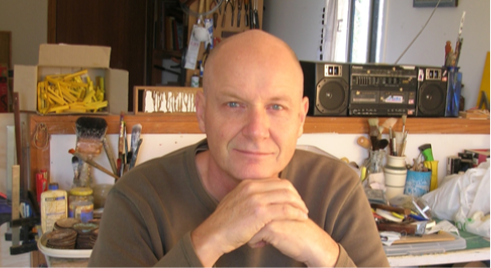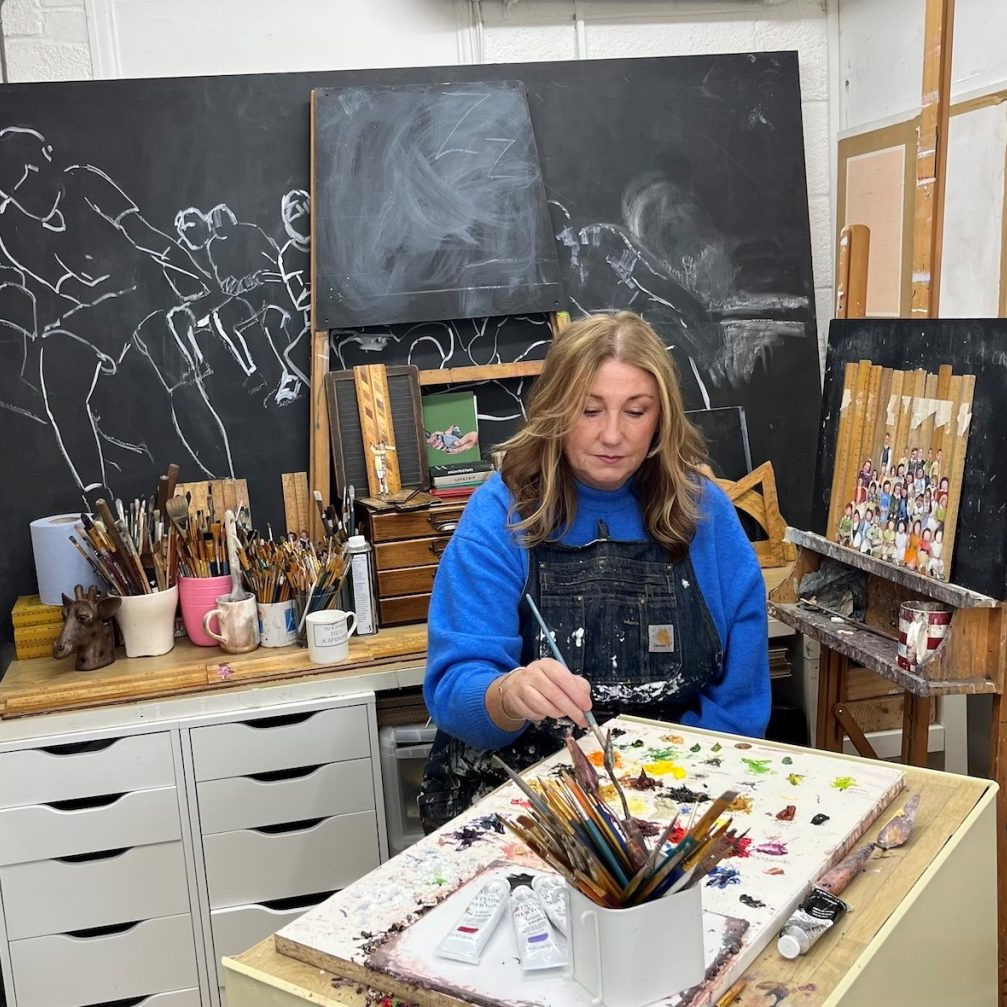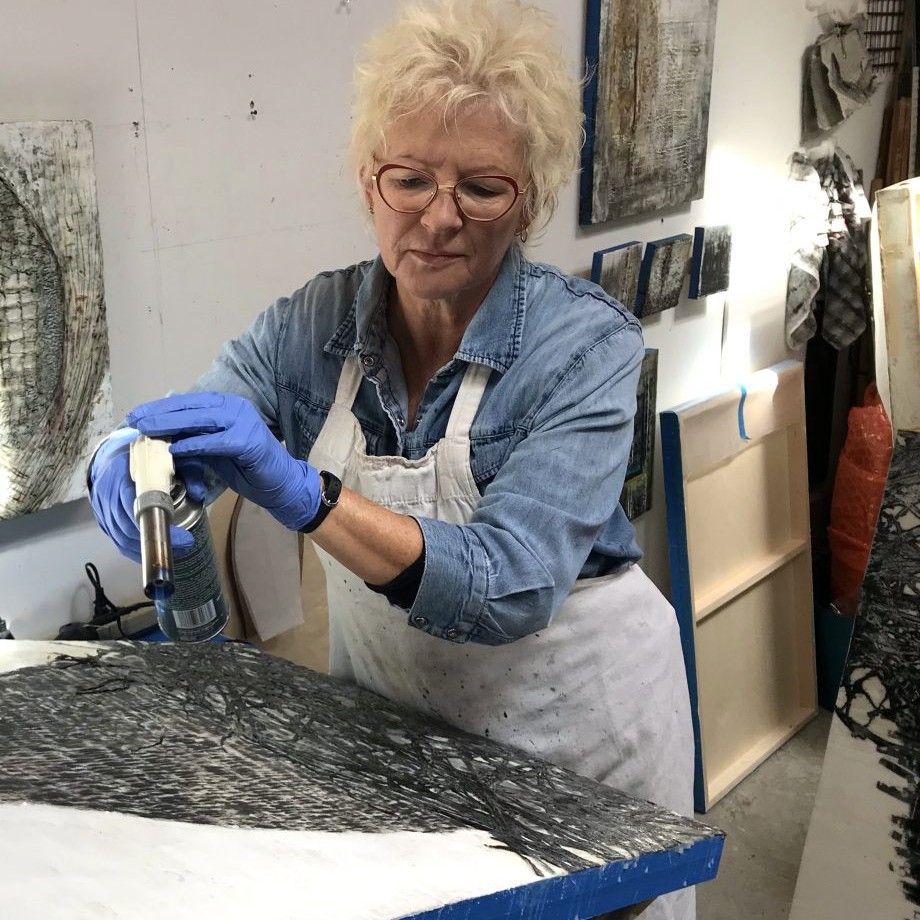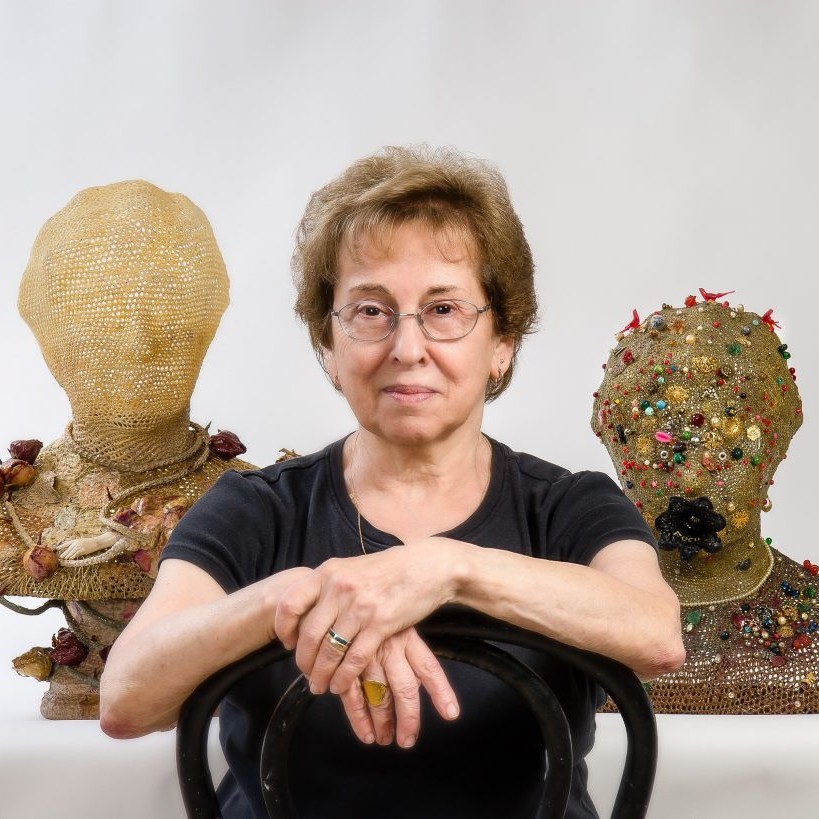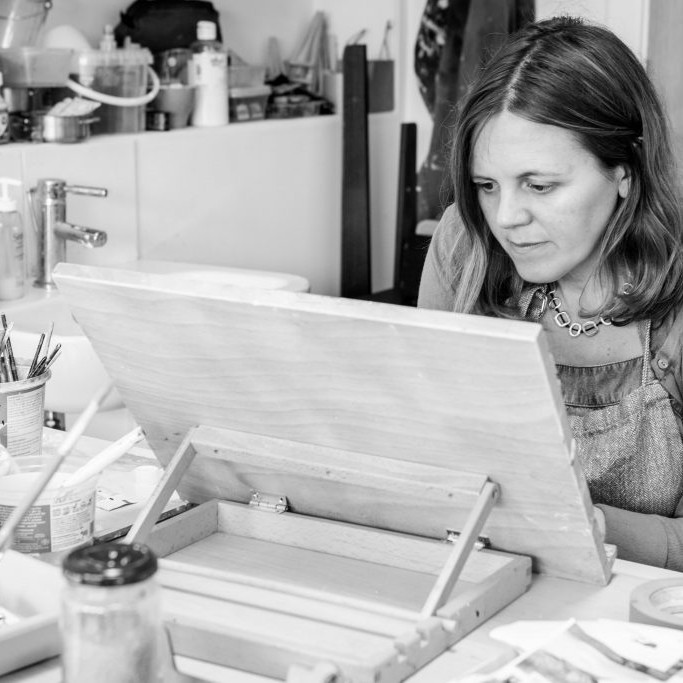Miles Allen Mixed Medium
Apart from the occasional landscape or portrait my art has always been geometric and abstract. It is hard to imagine doing anything else. I love creating order and rearranging shapes to get some uniformity.
I have two drawings from when I was about 10 years old. One is of coloured squares in the shape of a pyramid the other is a face with coloured squares all over it. It seems as though my passion for neatness, structure, logic and straight lines goes back a long time!
My work doesn’t often use curved lines. It may sound strange but I find them difficult to do. I like the certainty, the crispness of a straight line, a hard edge, a right angle and the repetition of shapes.
Have you always used recycled materials?
No, but I had always been conscious of just how much we throw away and had tried to minimise waste. I painted for the first ten years mostly acrylic on canvas.
In 2008 I found some old keyboards and worked with those for a while. I found some disused road signs and experimented with those and other signage items, then rulers and other measuring devices. More recently weathered and worn tin and metal.
About seven years ago whilst visiting France, I saw fruit and vegetable boxes at the market and was instantly drawn to them. They were decorated with simple stylised shapes and a variety of fonts, logos and descriptors and I had to get some! They have been my main source of art since then. Painting allows me the freedom to put anything on the canvas but with these boxes I only use what the material provides, with its printed logos and descriptors, its textures and evidence of prior usage. I have to incorporate what is already present.
Does your technique allow you to work on large scale 2D pieces or does it become too heavy?
I love creating large works, I find them challenging and I feel I can sometimes say a lot more in large works. There is something beautiful about one rusty tin or one cut-out apple, but put 100 of them together and you have something far more beautiful and completely different with the possibility of recurring patterns and motifs. With large works there seems to be greater need to balance the work, to step back from it and gauge its overall harmony.
Transporting large works is harder and yes, they are heavier so I normally construct them in two or three pieces.
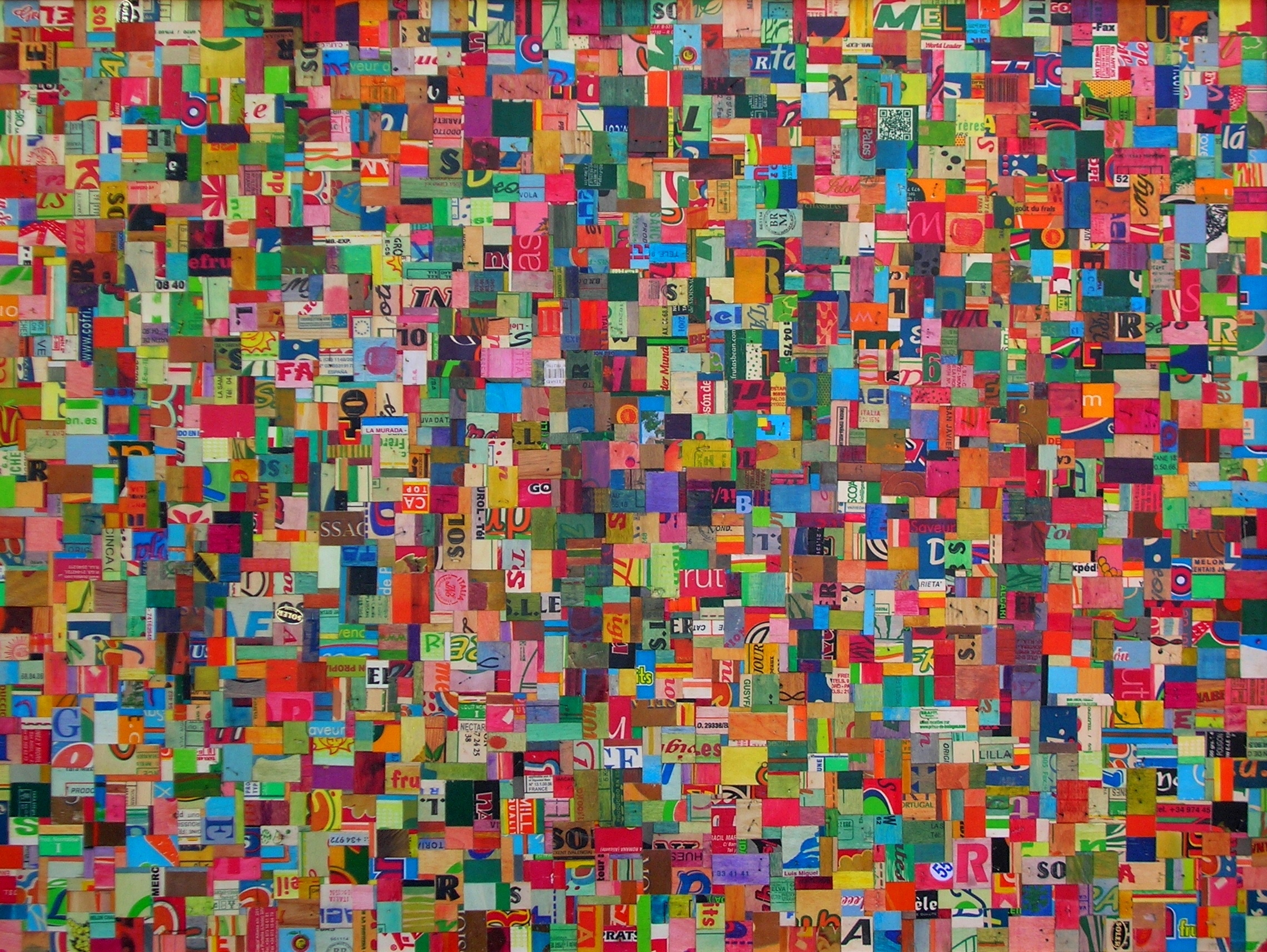
Why (2013) Plywood, ink, acrylic and wax. 90 x 120 cms
Discuss the importance of aboriginal art and Rosalie Gascoigne in the way your own art has developed?
In 2008, I saw an exhibition of Emily Kame Kngwarreye’s work at the Queensland Art Gallery and for me it was a seminal event, something that changed my creative life for ever. Her work was so varied, so colourful, so majestic and it all worked together – to my naïve view it looked so simple and I thought ‘I could create something like that’.
I wanted to do something that impacted on me, that I could look at and enjoy, knowing it had come from me. So I explored Australian indigenous art, finding out as much as I could about the different styles and the people who made it. And I played around with paint on canvas initially using the colours I saw in many indigenous works and just experimenting with lines, patterns, shapes and structures. There is a narrative within these works with an inherent structure and logic and an organic quality – there is something in a lot of indigenous art that touches my sense of symmetry and structure in an inexplicable sort of a way.
My first view of Rosalie Gascoigne’s work was of her deconstructed road signs I remember thinking what a brilliant idea it was to cut up things that were everywhere, yellow road signs with black paint and other items with letters and figures on them. I read more about her and discovered the variety of works she did and how she linked them to the landscape around her and it all resonated within. When I discovered the fruit and vegetable boxes I made an immediate association with Gascoigne’s work which deepened and activated the inspirational aspect of her work.
In 2010 you gained the commission to design a huge mural. Can you expand on this and discuss the planning and process?
I was approached by a construction company in Bella Vista, a suburb of Sydney and they were building a large office block. They wanted me to quote for the design of a mural covering a wall measuring 110 x 8.5 metres. I thought about this for long time – I had done commissions before but on a much smaller scale with clients who were happy for me to create what I wanted within loose parameters. How much say would I have in that, how would I actually do that, was I capable of meeting their needs, how could I envisage a wall of that gigantic scale and reduce it to a workable size? The wall, the project and the task were all huge so breaking it down into small steps with approval by the client along the way was for me very important. Here’s that need for structure again!!!
The quote was accepted and so the task began of meeting the brief of a mural with ’Mondrian-like qualities in blues and greens’. I collaborated on this commission with my son Tom Allen, an industrial designer who was living in Barcelona. We worked through many mock-ups before submitting seven options to the client. He chose one and then our task was to refine and develop this design. We eventually submitted the exact measurements so it could be transferred to the wall.
After two years, 400 emails and numerous Skype conversations the client was happy and after eight weeks a team of painters had completed the task of painting the wall.
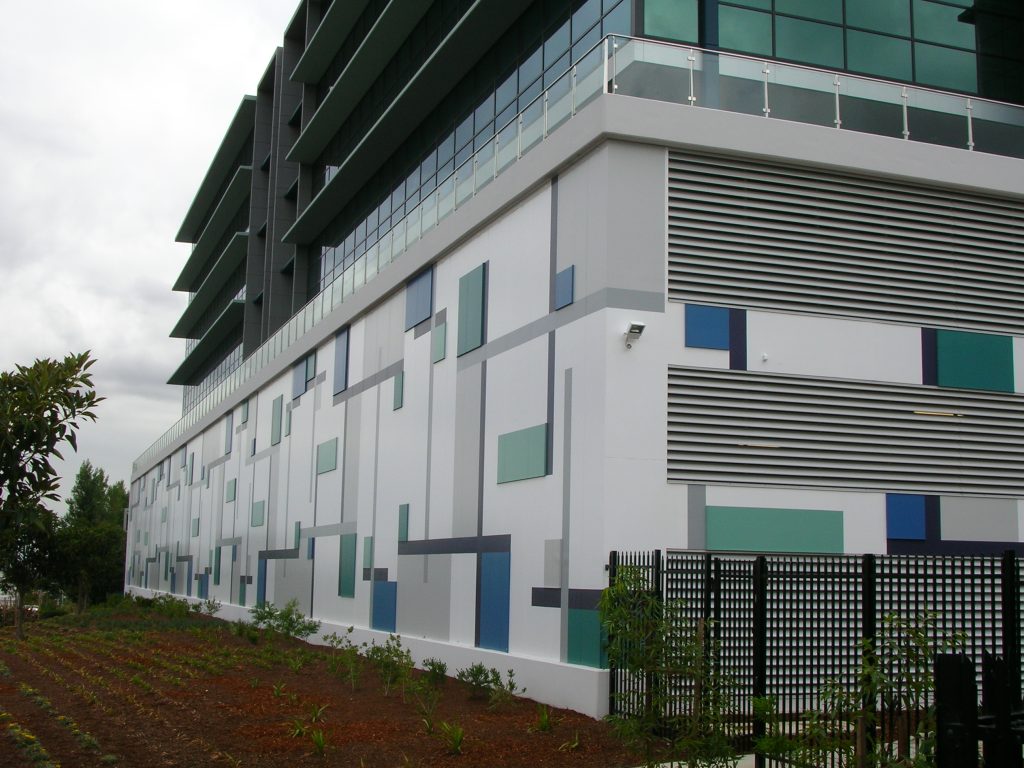
I went to Sydney for the opening of the building and my first face-to-face sighting of the building, the client and the mural. It was a fantastic experience to see the work – I was amazed at the imposing height of the wall. The work towered eight metres above me and I had to stand back a long way to see it all in one go. There was a huge adjustment in the mental picture I had constructed for myself and the actual physical experience of being in the presence of this wall.
The building is on a major road and 70 000 vehicles pass this mural every day and so it gets plenty of exposure.

Miles Allen-Mural 2, Bella Vista NSW (2012-4) 8.5 x 110 Metres
What are your thoughts on art in such public places?
I think art in such public places compensates for the coldness and rigidity of materials existing in our urban environments such as concrete, steel, metal rods, asphalt, pavements. All of which can have very uninteresting colours, forms and shapes being built from practical and cost-effective perspectives often at the detriment of aesthetics.
I think generally we are witnessing a welcome shift which is more integrative of visual beauty and which attempts to balance practicality with a visually pleasant and attractive urban environment. There is a well-documented link between lived-in environments and our mental well-being.
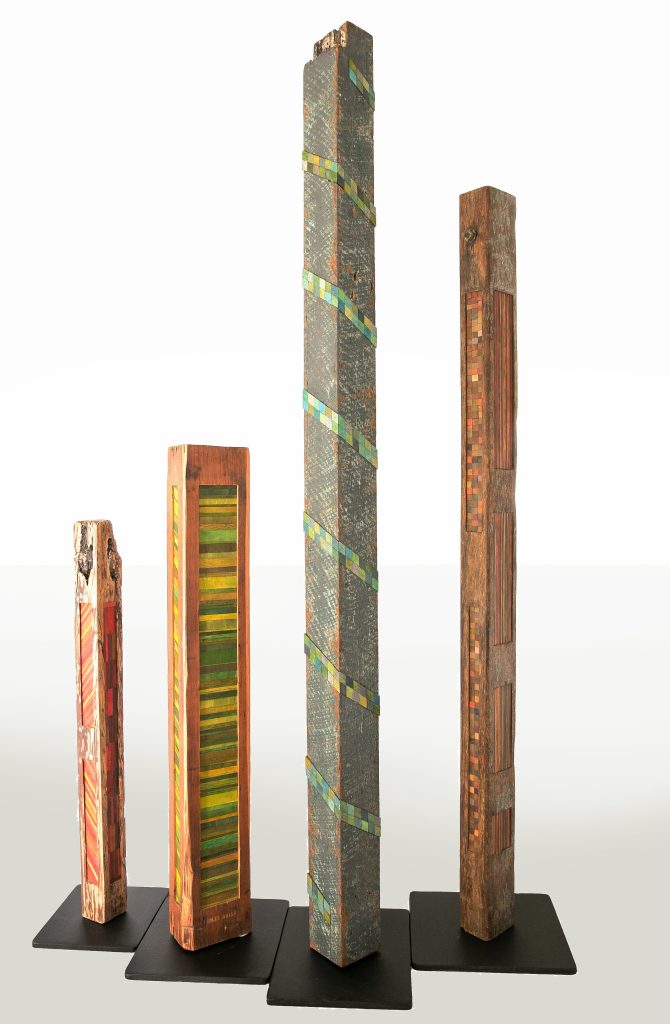
Posts of recycled timber inlaid with plywood (2014) Various sizes maximum 185 cms High
What comes first, the finding of materials or the idea/inspiration that then leads you on the search?
It is a bit of an interplay between the two though more often than not it is the materials that tend to lead the way to an art work. I think it is important to be attentive to the inner dialogue I have with these found objects and let them guide my creative process. Yet at times I have an idea at the back of my mind which drives my search through markets, garage sales, rubbish tips and recycling depots. It’s really about being openly curious and receptive to both materials and ideas and flow with the possibility of being surprised by unconventional ways of utilising objects and exploring ideas.
Can you expand on your use of rulers and other measuring devices?
My art practice has consistently relied on accurate measurement to create clean lines, close fitting shapes and patterns, so the act of measuring is a central part of facilitating accuracy in my creative process. I have always been drawn to rulers and other measuring devices and one day I bought an old wooden carpenter’s ruler. And then I bought another one and so on. I kept buying different types of rulers for a few years knowing that one day I would modify them for my art.
Cutting up these rulers to create something new challenged me and my attachment to these objects. They hold much beauty, marks of usage, wear and tear, and history. I aim to preserve and enhance their aesthetic aspect whilst changing them forever and giving them a new life.
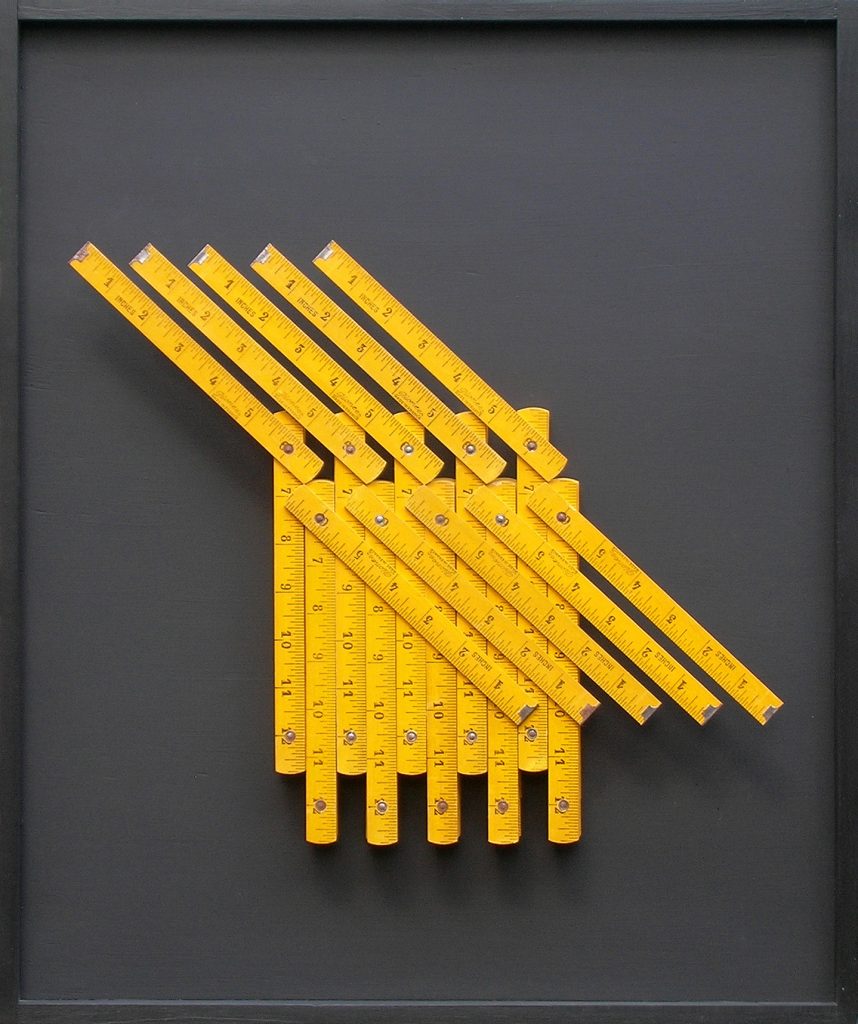
Pioneer (2012) Rulers on board. 53x44cm
The work Pioneer was created from a box of new unused rulers I found at a flea market in France. I instantly saw beauty in their colours, newness and regularity. I traded their functionality for a use which gave them a new purpose. Throughout the process of creating art using found objects I aim at preserving and enhancing the beauty I see in them whilst inviting viewers to explore their notions of art.
Discuss the similarity between your work and patchwork and quilts?
I constantly look for patterns in nature and in our built environment and am particularly drawn to the patterns found in some Amish quilts. Much of my work with recurring patterns allows people to make a connection with patchwork and quilting. I have rarely purposely made work to be similar to patchwork though The Spanish Quilt series of works was deliberately created to provide a resemblance to quilts.
I collected the materials used to create these works in Barcelona where my son was living and from markets around my partner’s home town in southern France and I brought them back to Australia. My mother used to do a lot of sewing and work with fabrics thus making these works re-created and enlivened the relationships and connections with those closest to me and memories were rekindled and enhanced. In these works each piece of timber connects to another in a rhythmic visual interaction. Thus a metaphor exists linked to my mother, son and partner – their connection with one another and with me is greatly enhanced.
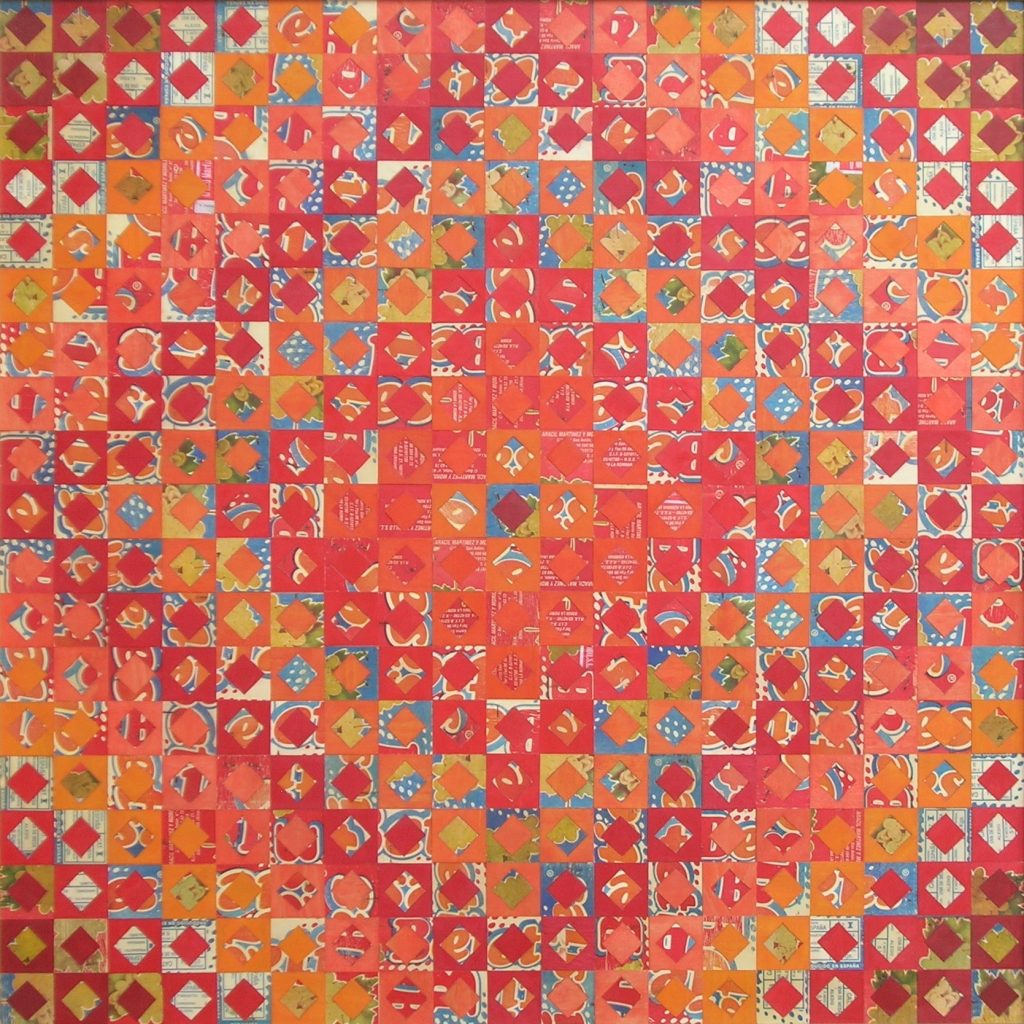
The Spanish quilt (2014) Plywood, ink and wax. 112×112 cms
Colour is a major aspect of your work. Expand on this and also the techniques you use to colour your materials.
I think of colour as the energy of my work. Colour is what binds it together and brings it to life. It is what defines a work in terms of its warmth/coolness, softness or sharpness. I sometimes work with extreme contrast and other times with semi-tones that subtly blend together.
I use a range of inks and diluted acrylics to tint the wood in my fruit and vegetable box compositions. I need to adapt the colouring pigments to the absorbent capacity of the woodgrain. I also need to take into account the existing colours present in logos and images printed on the wooden panels and the variation they bring. Again, it is about being open to various explorations in colour combination and the various density of tones how they either attenuate or bring out the underlying composition.
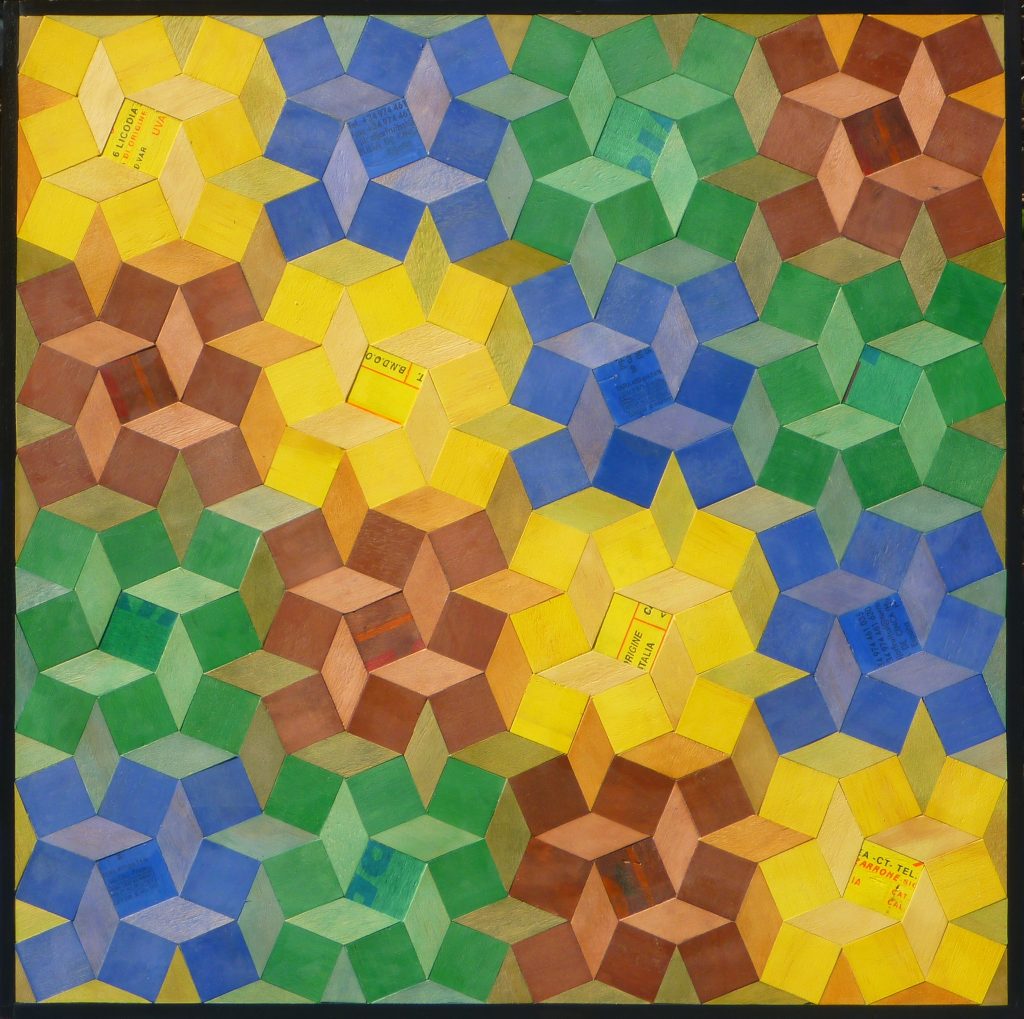
Four days in Marrakech. Plywood, ink and wax. 67 x 67 cms
Is your work related to the areas where you live?
I have lived in a variety of places since I left school and I have travelled widely. Like many people my environment and the people around me affects who I am. The studios I have worked in have always had views of trees and rural landscapes.
I am uncertain if my work with fruit and vegetable boxes would change greatly if I was living elsewhere. However, when I undertook residencies at Broken Hill and Hill End (both small, rural places founded on their rich, natural resources) I went with the specific intention of creating work directly related to those places; the materials I used were sourced from those places and gathering and working with them was an integral part of getting to know these places and creating work directly related to my surroundings.
Fruit plays a large part in your 2D work. Discuss.
Using fruit in my own compositions is an expansion of the little fruit printed on the boxes’ panels. I felt like bringing them out in larger scales and in isolation and I wanted to explore the diversity of their colours and the flowing lines of their shapes. Yet, because of my deep affinity with straight lines I have sometimes pixelated my representation of fruits so that the overall curves become apparent from a distance. It is also a way of celebrating the wide diversity of fruits that we have in Australia throughout all seasons as opposed to the scarcity of freshly picked fruit in the colder European climates.
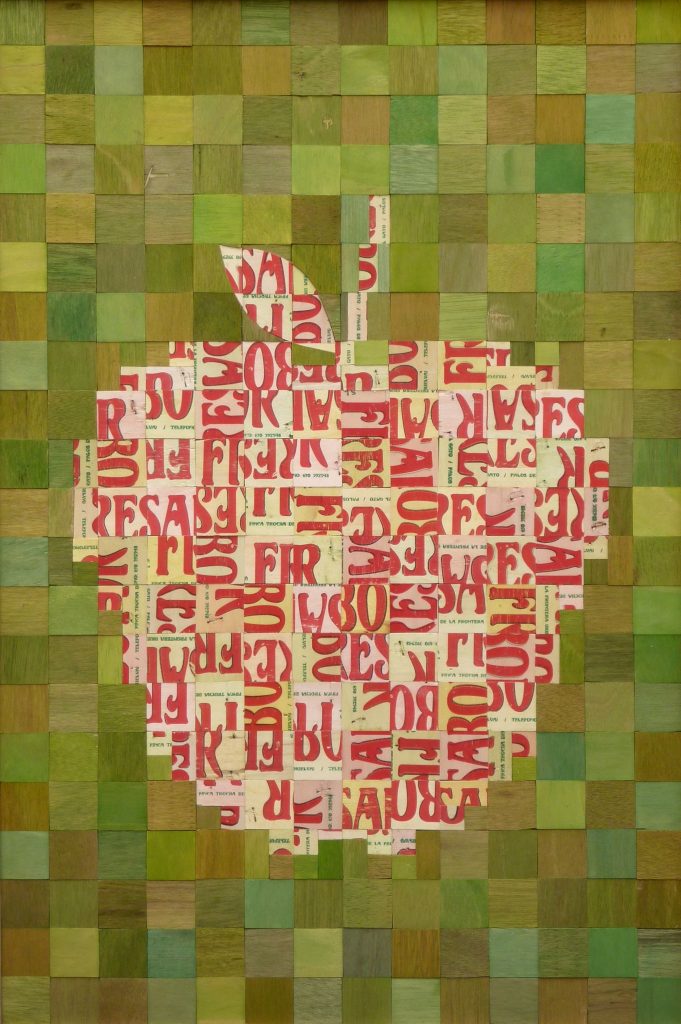
La Pomme (2012) Plywood, ink and wax. 90 x 60 cms
While you were working in Broken Hill (outback Australia) your work took on a very different look, discuss?
Broken Hill is a town on the edge of the outback with a hot desert climate. It was settled by Europeans because of its immense mineral wealth and since then it has remained a mining town. Much of the surrounding landscape has been ravaged and is devoid of trees and the town itself is dominated by the vestiges of mining though it has some beautiful heritage buildings.
I went there with the idea of recreating the landscape using plywood in a style similar to marquetry but shortly after getting there I soon realised that there was a whole world of other posibilities! When I go to a place I like to find out as much as I can by driving around it, walking, researching and reading about it, observing the inhabitants and looking at it through other people’s eyes. And by walking around randomly I get a closer connection to the land, I explore what seems like empty, sometimes deserted places and I observe nature.
On my walks I kept coming across abandoned bits and pieces, rusty metal, detritus from everyday living, remnants of mining and other thrown-away items. I kept picking up the bits which particularly interested me until before I knew it, a ‘pattern’ was emerging. My walks then became more purposeful, seeking items similar to what I had already collected and looking for materials and ways in which these items could be shown in an exhibition at the end of my residency.
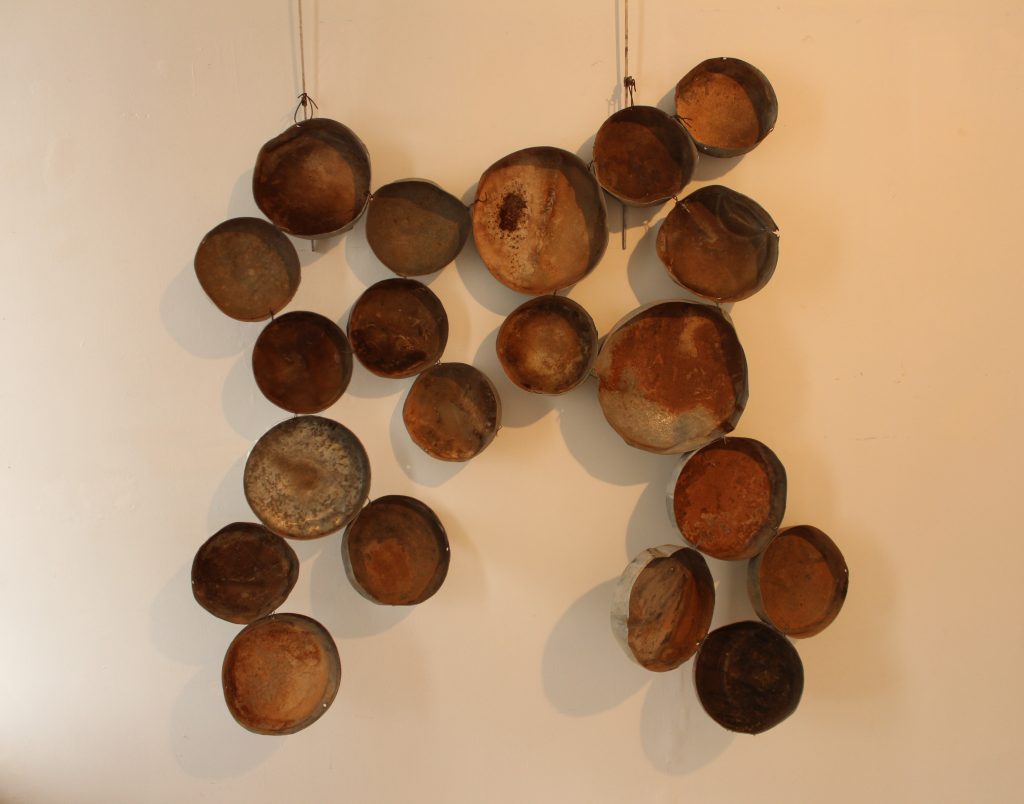
Poles apart (2104) Metal caps. 160 x 150 cms
The materials I used in the exhibition were discarded a long time ago as they had served their purpose, thrown on the scrap heap (literally) and forgotten. I had rediscovered and adapted them for another context and another purpose. Working in Broken Hill gave me the opportunity to expand my capacity for inventive variation and extend my visual vocabulary. For many years my art has been about seeing beauty in ordinary things, creating order, crossing cultures, joy, humour and repurposing. The exhibition, like my other ones, stuck to those principles.

United we stand, divide we fall (2014) Railway pegs. 15 x 100 cms
Contact details:
miles@milescallen
www.milesallen.com
Interview by Deborah Blakeley, July, 2015
Think a colleague or friend could benefit from this interview?
Knowledge is one of the biggest assets in any business. So why not forward this on to your friends and colleagues so they too can start taking advantage of the insightful information the artist has given?
Other artists you may be interested in:


